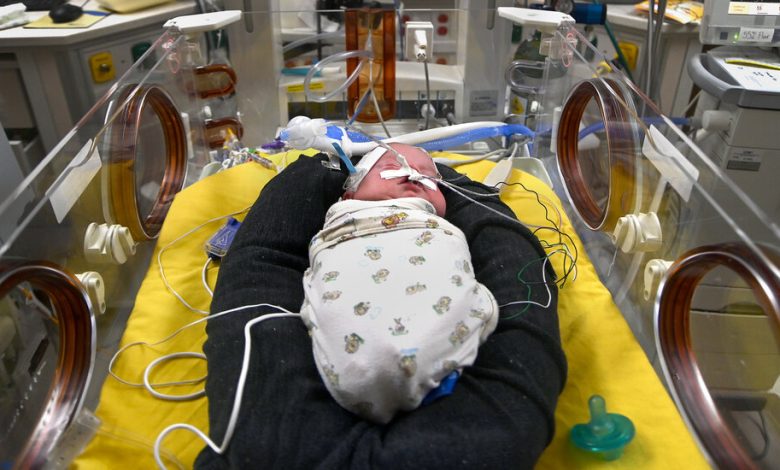A Simple Way to Save Premature Babies

The News
Shortly after a baby is born, doctors clamp the umbilical cord linking the infant to the placenta, which is still inside the mother’s uterus, and then cut it. New research shows that if doctors wait at least two minutes after the birth to clamp the cord, they significantly improve in-hospital survival rates for premature infants.
Delayed cord clamping — an intervention that can be introduced at relatively little cost — is believed to help because it allows umbilical cord blood, which is rich in iron, stem cells and antibodies, to flow back to the baby. Some experts say that it’s not entirely clear why the strategy seems to help, but that the data is convincing.

A premature baby born in a hospital in Iowa City in 2021.Credit…Michael S. Williamson/The Washington Post, via Getty Images
How It Works: Doctors wait to cut the cord.
The American College of Obstetricians and Gynecologists already recommends delaying clamping by 30 to 60 seconds for both full-term and preterm newborns.
Preterm babies are those born before 37 weeks of gestation. In preterm infants, delayed clamping leads to improved circulation, less need for blood transfusions and a lower incidence of serious complications, such as necrotizing enterocolitis, or inflammation of the digestive tract.
The evidence about whether the practice is beneficial for them has been inconsistent, according to Anna Lene Seidler, lead author of two new review papers and a senior research fellow at the University of Sydney in Australia.
The new research also sought to determine the optimal time to wait before clamping. The longest delays that were studied were three minutes after birth.
“We found that the longer we wait, the better, and the more we can reduce mortality,” Dr. Seidler said. “We were astounded by how consistent the findings are.”
Two new papers, published in The Lancet, analyzed dozens of studies involving thousands of babies born in hospitals in a range of countries, including Britain, India, Iran and the United States.
The Numbers: A two-minute postponement seems optimal.
One of the reviews compared the effectiveness of three techniques: immediate cord clamping, deferred clamping and milking an intact umbilical cord so that more blood flowed to the newborn.
The paper examined 48 randomized trials and analyzed data on 6,367 infants, finding that delayed cord clamping reduced in-hospital deaths of preterm newborns by one-third, compared with immediate cord clamping. There were no statistically significant differences between any other interventions.
A second review and meta-analysis, which included data from 47 trials with 6,094 participants, compared umbilical cord milking with immediate clamping less than 45 seconds after birth, between 45 seconds and up to 120 seconds after birth, and two minutes or more after birth.
The analysis found that the longest deferral of clamping increased survival the most, compared with immediate clamping. But the authors noted that if the newborn required immediate resuscitation, the cord should be kept intact only as long as resuscitation can be provided at the same time.
Why It Matters: Delayed clamping can be quickly implemented.
Worldwide, some 13 million premature babies are born every year, and almost a million of them die within a month of birth. A low-cost, low-tech intervention like delayed cord clamping has the potential to save many lives.
Preterm births are an enormous problem in the United States, where one in 10 infants is born prematurely. Rates are higher among Black and Native American babies than among white and Hispanic babies.
Preterm birth is one of the leading causes of death among American infants. Infant mortality rates rose last year for the first time in decades, according to the National Center for Health Statistics. Deaths are more common among Black babies.
But implementing a change in guidelines to delay clamping the umbilical cord for two minutes or more may be complicated. Many preterm babies in the United States are born by cesarean section and require resuscitation.
A delay might mean that the necessary equipment has to be brought into the operating room even though it should be kept in a sterile environment, like a neonatal intensive care unit, said Dr. Anup Katheria, director of neonatal research at Sharp Mary Birch Hospital for Women & Newborns in San Diego.
“I don’t think we know the full ramifications a change in guidelines could entail,” Dr. Katheria said. “But if it really reduces the risk of death, why would you cut the cord?”




